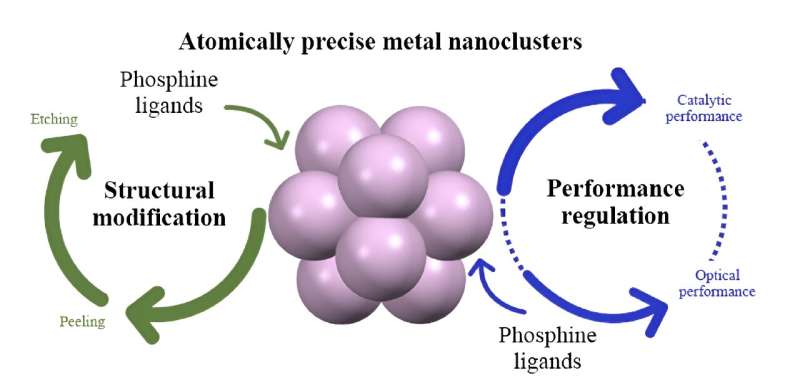This article has been reviewed according to Science X's editorial process and policies. Editors have highlighted the following attributes while ensuring the content's credibility:
fact-checked
proofread
Team reviews phosphine ligand-induced structural transformation of metal nanoclusters

A team of researchers has reviewed a unique method for reforming the structures of ultra-small nanomaterials. These nanomaterials, called metal nanoclusters, bridge the gap between the metal atom and the bulk metal, making them highly useful in both basic and applied research. Metal nanoclusters have the potential for wide-ranging applications in the biomedical fields.
The team's review paper is published in the journal Polyoxometalates.
The team investigated the phosphine-LEIST reaction. This method shows advantages in metal nanoclusters' structural modification and property modulation. "The method we reviewed is able to modulate the atomically precise structure of metal nanoclusters and regulate their corresponding performance," said Man-Bo Li, a professor at Anhui University, China.
Because of their remarkable size characteristics and precise structures, metal nanoclusters serve as bridges between nanoparticles and molecules. They provide scientists with an excellent platform for studying nanomaterials' structure and property modulation at the atomic level.
In recent years, scientists working in the field of metal nanocluster chemistry have gradually focused more on the effect of peripheral ligands on metal nanoclusters. Ligands are atoms or molecules that bind directly to the metal ion.
Scientists have progressively realized that organic ligands' spatial structure and bonding mode can significantly impact the properties of metal nanoclusters in terms of topology and electronic structure, solubility, stability, and related applications. So ligand engineering is becoming an essential branch of metal nanocluster chemistry.
Previously, nanocluster synthesis was achieved by metal doping and direct synthesis methods. Out of the direct synthesis method, scientists derived the ligand-exchange-induced size/structure transformation (LEIST). Many nanoclusters have been synthesized using the LEIST method. With LEIST, scientists have gained a deeper understanding of the transformation phenomenon in metal nanoclusters and broader application prospects.
The team examined the phosphine ligand-induced structural transformations and the corresponding catalytic and optical performance regulation of metal nanoclusters. They wanted to solve the contradiction between the stability and activity of metal nanoclusters.
"The ultimate goal is preparing ultra-stable and highly active metal nanoclusters for practical applications. The most exciting application would be catalysis because metal nanoclusters possess precise structures, abundant surface activation sites, and recycling capability. They are ideal industrial catalysts, combining the advantages of homogeneous and heterogeneous catalysts," said Li.
In recent years, scientists have proposed new potential uses for phosphine-protected metal nanoclusters by using the LEIST method for phosphine ligands. Phosphine ligands can transform metal nanoclusters' structure in a top-down evolutionary process that "peels" and "etches" for different template nanoclusters.
Phosphine ligands can also be used with other synthesis methods. Over time, researchers have discovered more and more phosphine ligands with different functional properties. Researchers are using these to modify the existing metal nanocluster structures. Phosphine ligands offer promising potential for the structural modification of metal nanoclusters.
The team's work highlights the critical importance of developing a wider variety of functionalized phosphine ligands. "As more and more phosphine ligands are designed and synthesized, the applications of metal nanoclusters in various fields will be significantly expanded," said Li.
In their review, the team focused on the phosphine-induced structural transformations of metal nanoclusters and their resulting performance regulation. They highlighted phosphine ligand-induced nanocluster transformations. They summarized the many achievements of structural modification by the phosphine-LEIST method using phosphines.
They also discussed the synergistic methodology of phosphine-induced structural modification combined with other synthetic methods. Finally, they summarized the potential role of phosphine ligand engineering in modulating metal nanoclusters' properties, such as optical and catalytic activities.
Through their review, the team determined that the phosphine-induced transformations of atomically precise metal nanoclusters hold great promise as research topics and deserve further exploration in developing and applying these metal nanoclusters.
More information: Wenwen Fei et al, Structural modification and performance regulation of atomically precise metal nanoclusters by phosphine, Polyoxometalates (2023). DOI: 10.26599/POM.2023.9140043
Provided by Tsinghua University Press




















